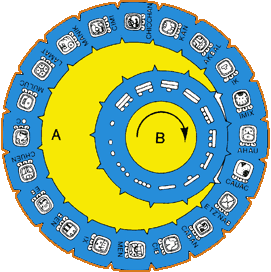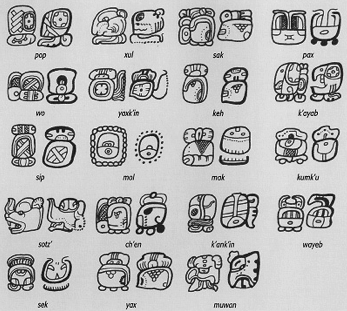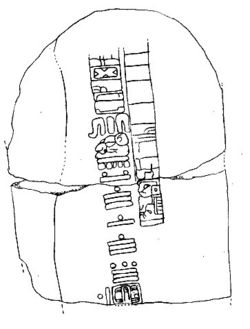The hard part is deciding on where to start, there's just so much to discuss. I think a look at ancient predictions and prophecies for this period of time we're in now, would be wise to start with.

Its become clear through research, that ancient civilizations were far more advanced than previously thought by scientists, specifically with regard to their understanding of that the solar system and the cosmos. Artifacts recovered from areas once inhabited by the Mayans, have revealed a detailed, complex and incredibly accurate calendar system the Mayans used to track time and the expanding, evolving consciousness of the solar system. Later we will look at how this calendar is of great importance in today's time. Lets first take a look at the mechanics of the calendar system..
The calendar was in fact a system of components each of which kept track of different cycles in time. The calendars main purpose however, was not to determine what day it was, like the Gregorian calendar we follow today, but rather to determine the spiritual aspect of each day and cycle.
The following is some information on the different components (calendars within the calendar), from www.mayan-calendar.com:
The Tzolkin Calendar
The 260-day Tzolk'in, or sacred calendar, is the oldest calendar cycle known in Mesoamerica, dating back to at least 600 BC. While some scholars are still searching for an astronomical basis for this cycle, most agree it was based on the nine month human gestation period. As a testimony to the tzolk'in's centrality to Maya culture, it is still observed today among traditional Maya groups.

The Haab, or "Vague" Year
The Haab, or "vague" year, is the one most similar to the Christian calendar. With 365 days in its count, it is obviously based on solar observations. It's called the "vague" year because, unlike the Christian calendar, it does not include a leap year. The Haab was in use by at least 100 BC and was created to be used in conjunction with the Tzolk'in.

The Eighteen months of the Haab (Image adapted from Voss 2000)
In operation together, the Haab and Tzolk'in create a larger, 52-year cycle called the Calendar Round that was used not only by the Maya but also by every other culture in Mesoamerica.
The Haab is made up of 18 months of 20 days each and a final short month of only 5 days. Together they form the 365-day, solar-based year. As with the Tzolk'in, each day is represented by a number-glyph combination, but the numbers are now 20, one for each day of a 20 day month. The first number of any given month is
mathematically in the place of zero (a concept with which the Maya were aware), but written hieroglyphically as "seating." The patron deity of the month assumes the throne on day zero and stays for the next 19 days. The final five days of the Haab cycle are the 19th month, called Wayeb. These are unpredictable days, not for planning important events or traveling away from home.
Despite the fact that a tourist can buy a charm with their "Maya month sign" in most of the publicly accessible ruins as if they were related to the concept of Greek zodiacal signs, the modern Maya assign no horoscope-like significance to these signs. It is the 260-day Tzolk'in, not the Haab that informs one of their personality traits and destiny. Contact period documents, especially the writings of Diego de Landa, do relate the existence of a festival cycle that followed the Haab.
The following is translation of each month name and a brief list of what was to be celebrated during each:
Pop - Mat (symbol of community and marriage)
The first month of the year, preceded by fasting and abstinence. On the first day of the year there was gift giving and drinking.
Uo - Frog
Physicians and shamans made offerings to Itzamna, the god of magic and patron of priests. Predictions for the year were made and individual priests were assigned their festival obligations for the year.
Zip - Red -- (perhaps red conjunction?)
A month to honor the god of hunting, Ek Zip. Hunters and fisherman blessed their tools and performed blood letting ceremonies.
Zotz - Bat
Bee keepers prepared themselves for the coming activities by fasting. It may have also been associated with the beginning of the darkest months of the year in fall.
Tzec - no known translation
The bee keeper festival occurred. Offerings were made to images of the four Chaaks (rain gods), and the rims of offering plates were covered in honey. Hive owners shared honey with the community.
Xul - Dog
The festival of Chicc-kaban, dedicated to Kulkulcan, the Feather Serpent. It was marked by processions to primary community temples, accompanied by troupes of comedians. Offerings were made at the temple and much incense was burned. The comedians continued to visit neighborhoods throughout the month, performing and bringing offerings back to the temple. At the end of the month, Kulkulcan was said to descend from the the heavens and collect the offerings.
Yaxkin - First (or Green) Sun
Preparations for the festivals during the next month. Instruments were anointed and many items were painted blue. Children were all given nine light raps on their knuckles to assure they would become skilled craftsmen like their parents.
Mol - Water or Jade
A month to make wooden effigies of the gods. Wood was chosen with care and carving was done with ceremony and blood letting. Carvers worked continuously, their families bringing them food and water, until the images were complete.
Chen - Cave or Well
The wooden effigies they had made the month before were delivered to shrines and valuable offerings were made to them as a way of "activating" them. Afterwards, the artisans were honored by feasting and drinking. In glyphs, the patron of this month is the Moon Goddess.
Yax - Green or First
The temples were renovated or repaired as needed. Ceremonies honoring Chaak the rain god and prayers for the maize fields were performed. In glyphs, the patron of this month is Venus.
Zac - White
The hunters had their second festival of the year, this one to ask for the forgiveness of the gods for shedding the blood of animals.
Keh - Red (or perhaps Deer)
No specific festival is recorded for this month, though some scholars believe it may have been connected to ceremonies honoring deer.
Mac - To Enclose, to Cover
Ceremonies led by the elders of the community honored Chaak and Itzamna. Fires were lit atop the temples and the hearts of birds and animals were thrown into the flames. When they were completely burned, a bucket of water was poured on them as if rain from Chaak had extinguished them.
Kankin - Yellow Sun
No festival is recorded for this month. J. Eric Thompson believed that the glyph Kankin represents the rib cage of a dog, and that this month was somehow associated with canines.
Muwan - The Moan Bird (relative of the owl)
During this month the owners of cacao plantations gave thanks to the gods who protected their trees. Dogs and blue iguanas were sacrificed in the groves and each of the officers was given a cacao branch.
Pax - Planting Time
This month was filled with ceremonies honoring warriors. Community members escorted the war chief to the temple and feasts and dances were conducted in his honor. Dogs were sacrificed and prayers for victory in future battles were made.
Kayab - Turtle
There are no recorded festivals associated with this month. Glyph associations point to the young Moon Goddess as the patron and perhaps ceremonies honoring child birth and midwives were conducted.
Kumku - Ripe Maize
No festivals are recorded for this month, but its name suggests harvest ceremonies occurred.
The Long Count

Tres Zapotes Stela - 31 BC
The long count is represented as a five place notation system of ascending cycles - kins (days), winals (20-day months), tuns (360 days), k'atuns (20 tuns), and bak'tuns (20 k'atuns). It is important to note that the long count's version of a year, the tun, is only 360 days, not the solar count of 365. This means that the long count diverges from the Haab by five days every year, making it a completely unique and separate cycle. The largest of the long count's five cycles, the bak'tun, is a period equaling 400 tuns. Many people believe that the full cycle of the Long Count is complete when 13 bak'tuns have passed since the beginning of the creation of this current universe, identified as the 4th creation in the Maya "story of creation", the Popol Vuh. That date, currently of such great interest to those anticipating an "end of days", will occur on December 21, 2012 AD.
The crux of the matter..
The mayans believed that we are on a divine schedule. They were counting down time towards the end of the 9 underworlds, or cycles of conscious expansion. The measuring started at the moment of the big bang, which they believe to have occured 16.4 billion years ago.
Each cycle was devided into 7 days and 6 nights. The days, periods of expanding conciousness and the nights a period of implimentation of that conciousness.
Here is a diagram of the nine underworlds devided into 13 periods of day and night..

We are currently in the 8th underworld, which began on Jan 5th 1999. The Galactic age. According to the calendar, we become aware of our galactic neighbors and our connection to the entire galaxy. We are now approaching the half way mark in the 6th day. A period of revelation and change. This calendar has been extremely accurate up until now, so it's time we start seriously acknowledging its relevance.
No comments:
Post a Comment